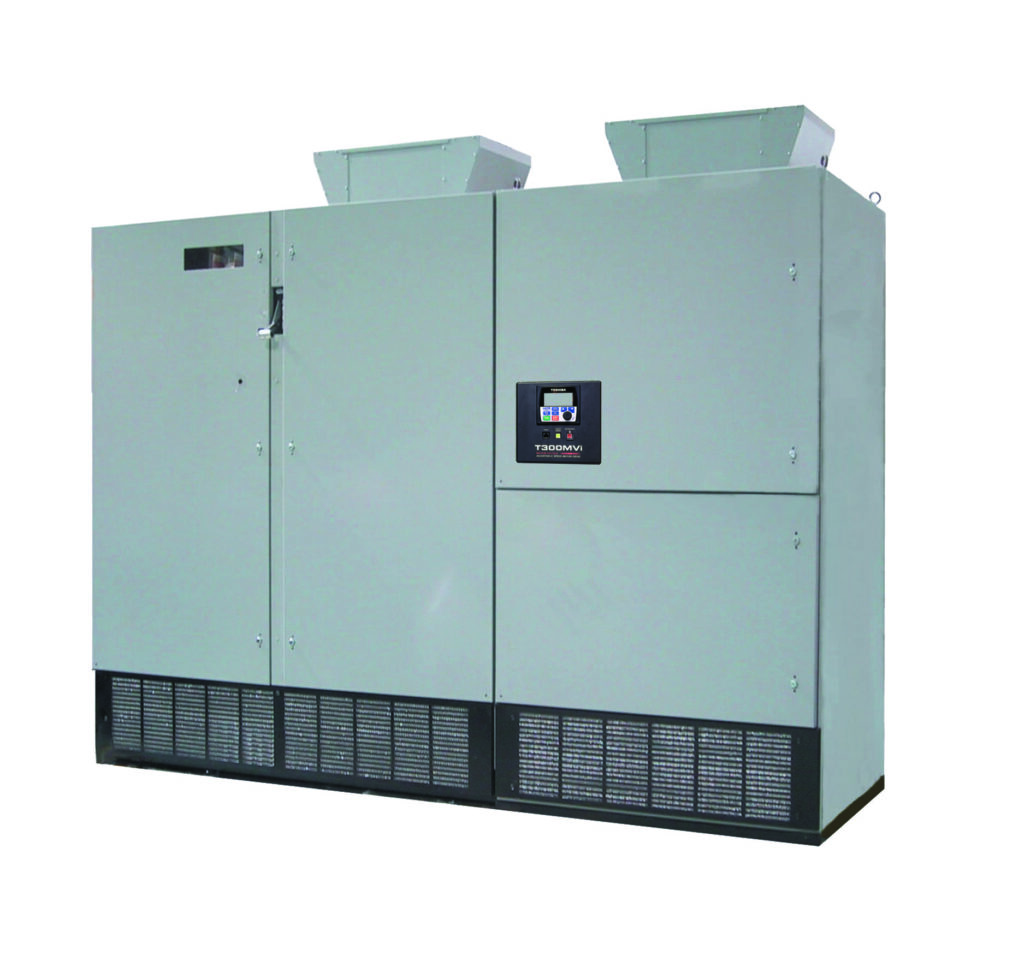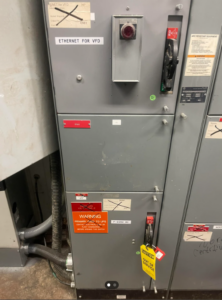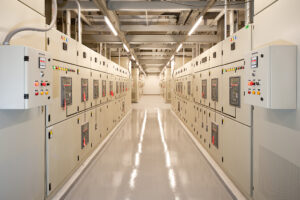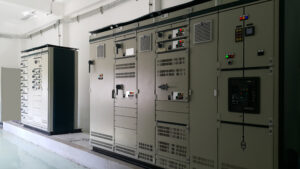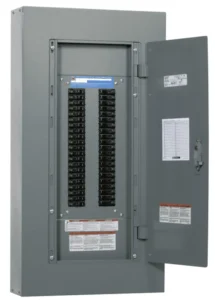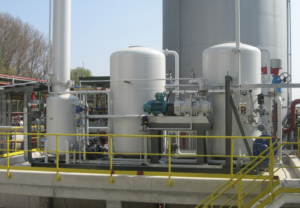Variable Frequency Drives (VFDs) provide electric motor speed control. By varying the frequency and voltage of the power supplied to an electric motor, VFDs fine-tune motor speeds to match the demands of various tasks.
Such tasks range from conveyor belt operation to water treatment pumping and ensure energy efficiency and operational precision tailored to each specific application. In this article, we review how VFD drives work, examine a variable frequency drive circuit, and discuss the advantages a VFD provides to users.
How VFD Drives Work
The fundamental value of a VFD is its ability to convert the constant frequency of incoming AC power into a variable frequency output. This conversion modulates the speed of AC motors, adapting their performance to the specific requirements of the task at hand.
The operation of a VFD is segmented into three core stages: rectification, DC link operation, and inversion.
Rectification
This initial stage converts the incoming AC power supply into DC power. In most VFDs, this occurs via a diode bridge rectifier. The rectifier’s primary function is to allow current to flow in only one direction, thus converting the bidirectional AC into a unidirectional DC. This stage sets the foundation for the subsequent modulation processes, ensuring a stable DC output that can be further manipulated.
DC Link (Intermediate Stage)
Following rectification, the DC power enters the DC link. This section contains capacitors and sometimes inductors, which buffer and smooth the DC power, eliminating ripples and fluctuations. This smoothing ensures that the inverter stage can produce a high-quality AC waveform. The DC link acts as a reservoir of energy, maintaining a steady DC voltage that feeds into the inverter stage.
Inversion
The final stage, where the actual ‘variable frequency’ aspect of the VFD comes into play, is the inverter. Utilizing advanced electronic switches, such as IGBTs (Insulated Gate Bipolar Transistors), the inverter converts the smoothed DC power back into AC. However, unlike the fixed frequency AC supply input, the inverter can output AC power at variable frequencies and voltages.
The inverter’s control method, often pulse-width modulation (PWM), is the key to this variability. PWM controls the duration and sequence of the IGBTs’ switching, effectively creating a synthesized AC sine wave with adjustable frequency and amplitude. This synthesized wave drives the motor, allowing for its speed and torque control.
By altering the frequency of the output AC wave, the VFD controls the speed of the AC motor. A lower frequency slows the motor, while a higher frequency increases speed. Moreover, the ability to fine-tune the voltage and frequency allows the VFD to adapt the motor’s performance to the specific demands of the application, whether it requires high torque at low speeds or efficient operation under variable load conditions.
A Variable Frequency Drive Circuit
Rectifier Stage Components
The rectifier stage employs diodes or thyristors depending on the VFD’s design and application requirements. Diodes offer uncontrolled rectification, suitable for applications where fine control over the motor start-up process is not critical. In contrast, thyristors allow for controlled rectification, enabling more nuanced control over the DC output. This can be particularly beneficial during motor start-up, reducing motor and connected equipment stress.
Active Front End (AFE) Technology
Some advanced VFDs incorporate Active Front End technology in the rectification stage. AFE uses IGBTs to control rectification actively, offering benefits such as improved power factor correction, reduced harmonic distortion, and regenerative braking capabilities. This technology enhances the VFD’s efficiency and compatibility with the power grid, making it ideal for applications with stringent power quality requirements.
DC Link Design Considerations
The DC link, bridging the rectifier and inverter stages, provides stability to the VFD’s output. The capacitors in the DC link must be carefully selected based on their capacity to store and smooth out the DC power. Additionally, including inductors can reduce ripple, leading to a more stable DC output. The design and quality of the DC link components directly impact the VFD’s performance, particularly in demanding applications with frequent load fluctuations.
Inverter Output Modulation
The inverter stage, equipped with IGBTs, is where the VFD truly showcases its capability to tailor the motor’s operation. The choice of modulation technique, such as Sinusoidal Pulse Width Modulation (SPWM) or Space Vector Modulation (SVM), influences the quality of the output waveform and the efficiency of the VFD. These techniques determine how the IGBTs are switched on and off, shaping the synthesized AC waveform that controls the motor. Advanced modulation strategies can minimize harmonic distortion and improve the motor’s performance and energy efficiency.
Control and Feedback Mechanisms
The control algorithms and feedback mechanisms that govern the VFD circuit are integral to its operation. These systems continuously monitor the motor’s speed, torque, and overall performance, adjusting the inverter’s output in real time to meet the desired operational parameters. This closed-loop control is essential for applications requiring precise speed regulation, load matching, or torque control.
Protective Features
VFD circuits are also equipped with various sensors and protective features to safeguard the VFD and the motor against overcurrent, overvoltage, overheating, and other potential hazards. These protective measures ensure the longevity and reliability of the VFD system, especially in industrial environments where durability and uptime are critical.
The Advantages a VFD Provides
The advantages of Variable Frequency Drives (VFDs) extend far beyond simple motor speed control. They offer a broad spectrum of benefits that enhance operational efficiency, cost-effectiveness, and system longevity. This expanded exploration delves deeper into VFDs’ multifaceted advantages, highlighting their transformative impact on industrial and mechanical systems.
Energy Efficiency and Cost Savings
One of the most significant benefits of VFDs is their ability to dramatically reduce energy consumption, particularly in applications requiring motors to run at less than full speed for extended periods. By adjusting the motor speed to match the actual load requirements, VFDs minimize energy waste, leading to substantial energy savings. This results in lower operating costs and contributes to sustainability efforts by reducing the carbon footprint of industrial operations.
Extended Equipment Lifespan
VFDs contribute to the extended lifespan of motors and connected mechanical components by enabling soft start capabilities. By gradually ramping up the motor speed, VFDs reduce mechanical stress and wear on motor components and drive systems, such as belts and gears, prolonging their operational life. This soft start feature also reduces the likelihood of electrical surges damaging sensitive equipment.
Improved Process Control and Product Quality
VFDs’ precise speed and torque control allow for significant improvements in process control, leading to enhanced product quality in manufacturing and production environments. For instance, in applications such as material handling or packaging lines, finely tuning the motor speed ensures consistent and accurate operations, reducing waste and improving overall product consistency.
Reduction in Maintenance Costs
VFDs can reduce maintenance costs by monitoring motor performance and identifying potential issues before they lead to significant downtime or damage. The ability to adjust motor speed and load conditions also means that mechanical components are less likely to be subjected to extreme conditions, thereby reducing wear and tear and extending maintenance intervals.
Enhanced System Flexibility
VFDs’ versatility allows for seamless integration into various applications, from simple fan and pump systems to complex industrial machinery. This flexibility enables system designers and engineers to optimize the performance of different mechanical systems, tailoring operations to specific requirements and conditions.
Harmonic Reduction and Power Quality Improvement
Advanced VFDs are equipped with harmonic mitigation technologies that reduce harmonic distortion, a common issue in electrical systems. By improving power quality, these VFDs help prevent disruptions and potential damage to other equipment connected to the same power network, ensuring stable and reliable operations across the board.
Dynamic Braking and Regenerative Capabilities
Specific VFD models offer dynamic braking and regenerative capabilities. These capabilities allow energy generated during motor deceleration to be either dissipated safely or fed back into the power grid, further enhancing energy efficiency and reducing operational costs.
Adopting VFD technology brings about a paradigm shift in how motor-driven systems are operated and managed. The advantages offered by VFDs underscore their role as a cornerstone technology in modern industrial automation, providing a pathway to more sustainable, efficient, and reliable operations across many sectors.

